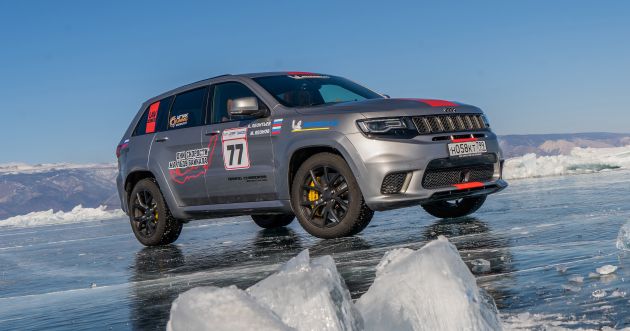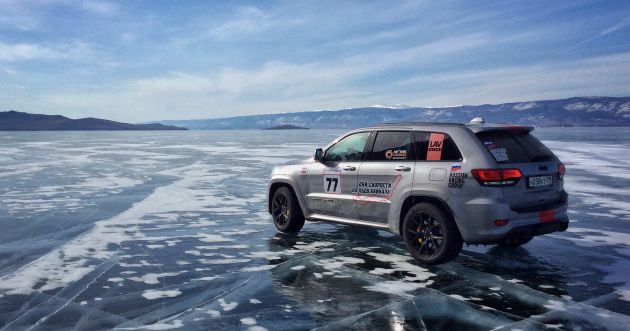The Jeep Grand Cherokee Trackhawk has set the official speed record for the fastest SUV driven on ice. This took place at the annual Speed Days of the Baikal Ice Motor Sports Festival 2019 in Russia, and data collected from the run was confirmed by the Russian Automobile Federation (RAF).
According to GPS trackers, the maximum speed achieved when driving on ice was 280 km/h. The Grand Cherokee Trackhawk was able to achieve an average speed over a distance of one km of more than 257 km/h with a rolling start and an average speed starting from a standstill of more than 100 km/h.
Just to remind you, Jeep labels the Grand Cherokee Trackhawk as the most powerful and quickest mass-produced SUV in the world. It’s powered by a 6.2 litre supercharged V8 engine pumping out 707 hp and 875 Nm of torque, does the 0-60 mph (0-96 km/h) in 3.5 seconds, the quarter mile (400 metres) in 11.6 seconds and has a top speed of 290 km/h. It even features a beefier TorqueFlite eight-speed torque converter automatic transmission and upgraded driveline components to handle the additional torque output.
Apparently, during the day, the surface of the lake was covered in a film of water, which reduces grip on the surface. Even so, the SUV benefited from the Brembo brake system – the Brembos are the largest standard front brakes ever offered on a Jeep. Up front are 400 mm two-piece vented rotors with six-piston calipers, and the rears are 350 mm vented rotors with four-piston calipers. They bring the 2.4-tonne Trackhawk to a stop from 60 mph (96 km/h) in 34.7 metres.
Of course, Jeep’s Quadra-Trac on-demand four-wheel drive system is also present, which includes an electronic limited-slip rear differential and a single-speed active transfer case, and the Selec-Track system with five dynamic modes – Auto, Sport, Track, Snow and Tow.
Before the speed record attempt, several items were removed from the Grand Cherokee Trackhawk. All runs were conducted in line with the regulations of the Russian Fédération Internationale de l’Automobile (FIA). The maximum average speed was counted over a distance of one km with a rolling start; the drivers had to cover one km in the middle of the track at the maximum possible speed and one km from a standing start.
The rules also dictated that the timing gates needed to be passed in both directions, with the judges calculating the average result. To allow for the required acceleration and braking, the total length of the course was 12 km. Additionally, the absolute maximum speed achieved in each run was included in the official Book of Records of Russia.
The Baikal ice festival was first held in 2011, and over the course of eight years, more than 20 speed records have been set on the Baikal ice in different categories of vehicles. All runs are traditionally conducted on natural bare ice and preparation of the route is limited to the removal of obstacles (packed snow, hummocks) affecting safety for drivers and judges. Achievements are recorded by licensed judges from the Russian Automobile Federation, using timekeeping equipment approved by the FIA.
Source: Read Full Article


